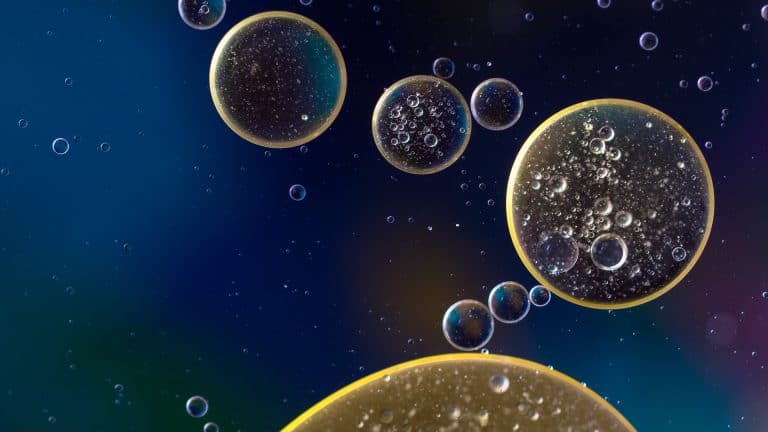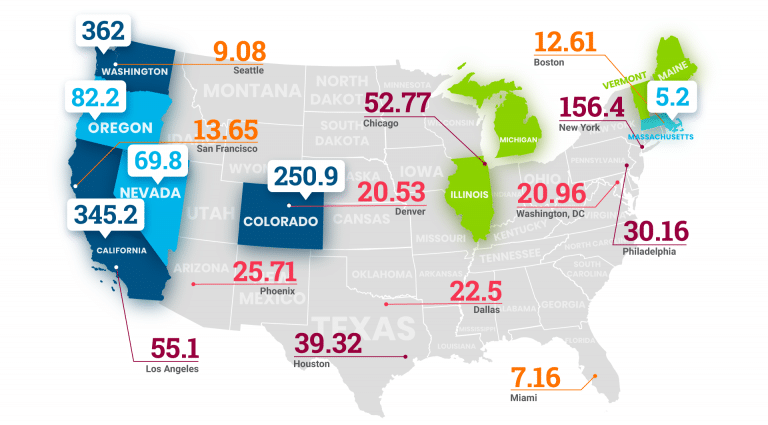51+ Formidable Cancer Statistics We Should Know in 2024

While people are discussing whether it is cancer or Covid19 that is more dangerous, how about we study cancer statistics and learn more about the disease itself, cancer types, victims, and survivors.
The disease manifests in many different forms, and just as there is no single cause, there still isn’t a universal cure either.
On the other hand, at least there have been some improvements in the marijuana and cancer department. The research is still insufficient, but cannabis seems to be very successful in fighting the disease.
10 Shocking Stats and Facts About Cancer
- Cancer cells can travel through the body.
- Cancer drugs bring the highest revenues in the pharma industry.
- Childhood cancers are different from adult cancers.
- Lung cancer is extremely deadly — over 50% of patients die one year after they were diagnosed.
- Breast cancer is the most common cancer in women besides some types of cancer that develop on the skin.
- Cannabis oil is better than classic opioids in treating cancer pain.
- Approximately 700,000 Americans are living with a brain tumor.
- The US cancer death rate has dropped by 27% in the last 25 years.
- Children’s cancer survival rates are higher than adult survival rates.
- Belgium is the country with the highest rate of women breast cancer.
What Are Some Basic Cancer Statistics and Facts?
Here is essential information, facts, and figures on the deadly disease.
1.There will be 2,506,267 new cancer cases in the US in 2025.
(Global Cancer Observatory)
According to the predictions of the Global Cancer Observatory, by 2025 there will be about 2,506,267 new cases of cancer in the US. This means that an increase of 9.8% is expected.
2. Cancer is the second leading cause of death in the US in recent years.
(CDC)
While the US is breaking all records in technology and science, it is still struggling to significantly lower cancer mortality rates. The first place in the infamous list of main causes of death for Americans belongs to heart disease, but cancer and heart disease are currently neck and neck.
3. Breast cancer and melanoma have high survival rates when caught early.
(Disabled World)
On the other hand, the highest survival rate (95%) belongs to one of the rarest — testicular cancer.
4. The deadliest cancer in the USA is lung cancer.
(Cancer Journal)
One-quarter of all cancer-related deaths in the US is attributed to lung cancer. Only 10% of patients who were diagnosed with it live more than five years after the diagnosis.
Lung cancer death grim statistics are a direct consequence of the tobacco epidemic. Nevertheless, the rates have significantly dropped since 1991.
5. What causes cancer in a person is still a mystery.
(Stanford Health Care)
Cancer develops under a synergetic impact of different influences. These can be a dangerous lifestyle (smoking, working with harmful materials, bad diet, etc.), toxic environment, radiation, genetics, viruses, or even chemotherapy. Nevertheless, it’s usually hard to pinpoint which exact factor contributed to a person’s disease.
6. Cancer cells can travel through the body.
(Your Genome)
A genetic mutation causes uncontrollable cell growth, which can eventually turn into a tumor. Cancer statistics note that the biggest problem with all cancer types is that as the tumor grows and suppresses the surrounding tissue, cancer cells break into the bloodstream and are able to spread into the other areas of the body.
7. Cancer drugs bring the highest revenues in the pharma industry.
(Statista)
Without any doubt, the first place belongs to oncology drugs — they are almost three times more expensive than the runner-up diabetes drugs.
In 2018 the sales hit $123.8 billion, but the amount is expected to almost double by 2024 due to the rising demand.
8. How many people die from cancer each year? According to the American Cancer Society, there were about 606,520 cancer deaths in the US in 2020.
(Cancer Journal)
For most cancer deaths in 2020, the main culprit was lung and bronchus cancer. In other words, this type of cancer killed about 135,720 people in the US. On that note, based on the statistics, men were more affected by lung cancer than women.
9. Statistics on cancer rates by state show that Kentucky has the highest overall cancer death rate.
(Becker’s Hospital Review)
In accordance with the 1999-2018 data, Kentucky is leading by 181.6 cancer deaths per 100,000 people, followed by Mississippi with 179.7, and West Virginia with 179.5 cancer deaths per 100,000 people.
10. Cancer facts show children’s cancer survival rates are higher than adult survival rates.
(Stanford Health Care)
The five-year survival rate for children is around 80%, whereas for adults the percentage is 68%. Generally, children react better to cancer therapy (even aggressive ones).
11. Childhood cancers are different from adult cancers.
(Stanford Health Care)
The cancers usually originate from different cells. While cancer usually originates from children’s stem cells, and it is thought that a random cell mutation is responsible for the dangerous disease, it is epithelial cells that show abnormal behavior in adults.
Breast Cancer Facts & Stats
One of the most common cancers, breast cancer affects both men and women, though not equally.
12. Over 3.5 million women fought breast cancer in the first trimester of 2020.
(Breast Cancer) (American Cancer Society)
This refers to the women who have survived and those who were struggling at the moment. According to statistics, 85% of the women diagnosed with the disease are the first ones in their family to suffer from it.
At the same time, in agreement with global cancer statistics from 2019, conducted by the American Cancer Society, one in eight women, or 13%, might get breast cancer during their lifetime. However, only 3% will lose the battle with this type of cancer.
13. Early signs of breast cancer can be identical to the symptoms of invasive breast cancer.
(Cancer Center)
Early signs may include a change in the size of the breast(s), feeling of pain, lumps or nodes beneath the skin, changes in the nipples’ appearance, and nipple discharge (not milk)However, some of these are identical to the symptoms of invasive breast cancer.
14. Breast cancer awareness month will begin on October 1st and it will end on October 30.
(Awareness Days)
The US public awareness was raised in this way for the first time in October 1985, and it started as a seven day program.
15. There will be 276,480 new cases of invasive breast cancer, based on breast cancer statistics for 2021.
(Breast Cancer) (Cancer Research UK) (Nature)
The most important factors for developing breast cancer are sex (being female) and age. The older a person is, the greater the chances. Although the overall death rate dropped by 1.3%, the stats show us that close to 42,170 women passed away in 2020 from breast cancer.
Unlike the US, cancer statistics in the UK from 2019 predicted the decrease in breast cancer death rates by 13%. The number of breast cancer referrals dropped by 28% at the beginning of 2020. On top of that, the overall number of patients that needed to go through breast cancer treatments decreased by 16%.
16. Belgium is the country with the highest rate of women breast cancer.
(World Cancer Research Fund)
Luxembourg and the Netherlands follow while the US is in the 22nd position.
17. Breast cancer is the most common cancer in women besides some types of cancer that develop on the skin.
(CDC) (Breast Cancer)
According to 2020 estimations, around 30% of newly diagnosed cancer cases among women will be breast cancer. 1 in 8 women is expected to suffer from breast cancer during her lifetime. A man’s lifetime risk is much smaller as only one in 883 men is expected to develop breast cancer.
Most Worrying Skin Cancer Statistics
If you’re already depressed by the above stats, you may wish to skip this section.
18. Skin cancer is the most diagnosed cancer in the US.
(SCF)
The number of diagnosed cases is higher than all the other cancers combined. It will affect one in five Americans by the time they turn 70.
19. The number of new melanoma cases per year increased by 54% in ten years.
(SCF)
This can be related to a variety of factors in the period 2009–2019. What is for certain is that increased UV radiation is to blame. In addition, indoor tanning is considered guilty for 419,000 cases of melanoma every year.
20. The five-year melanoma survival rate for stages 0, I, and II is 98%.
(Melanoma Research Alliance)
The survival rate for stage III is much lower — 63.6% advancements in immunotherapy and targeted therapy are said to be most helpful.
21. Melanoma is the most diagnosed cancer among young adult Americans (25 to 29-year-olds).
(Melanoma Research Alliance)
Also, white people have 20 times bigger chances of being diagnosed than black people, which is not to say the latter population is immune to the disease.
22. Over 1 million Americans are living with melanoma (even without realizing it).
(AAD)
It can be cured in its early stages, and yet about 20 Americans die from melanoma on a daily basis. That said, 196,060 people in the US are diagnosed with melanoma.
The most common skin cancer is basal cell carcinoma (BCC), normally developed in people with fair skin.
23. One in three diagnosed cancers originates from skin cells.
(WHO)
UV damage due to the holes in the ozone layer contributes to the appearance of new cases.
24. It can occur even in areas that are not sun-exposed.
(SkinVision)
Naturally, the areas most exposed to the sun (lips, arms, scalp, face, etc.) are most at risk, but cancer can appear even inside the mouth cavity.
6 Lung Cancer Statistics
One of the most feared cancers by all smokers.
25. Lung cancer is extremely deadly — over 50% of patients die one year after they were diagnosed.
(American Lung Association) (Lungevity)
The five-year survival rate is extremely low (only 18.6%). One of the reasons for such a shocking rate could be the fact that, generally, this type of cancer is diagnosed at an early stage in only 16% of the cases.
If you want to know what is the #1 cancer killer? The answer is lung cancer. Over 8 million Americans are at risk of getting diagnosed with this type of cancer. On a related note, according to the latest cancer awareness calendar, the first of August became known as the World Lung Cancer Day.
The color of the ribbon representing lung cancer is pearl or white.
26. African Americans are at a greater risk of developing lung cancer.
(ACS) (NCBI)
Cancer statistics show that out of all the racial or ethnic groups, African Americans have the lowest cancer survival rate for a majority of cancers.
27. In 2020, there were around 227,875 lung cancer diagnoses.
(Global Cancer Observatory)
Lung cancer is more common in men than in women. According to the mortality stats, 138,225 people lost their lives to the disease.
28. Most common cancer cause is smoking and exposure to radon.
(American Lung Association)
Smoking is held responsible for 90% of the cases, but other factors are contributors, too. Radon is a radioactive gas that is found in soil and emitted through cracks. One in 15 American homes is exposed to this odorless gas.
29. The most common age for getting diagnosed with lung cancer is around 70.
(ACS) (Very Well Health)
Based on lung cancer statistics, only a small number of people under 45 years old are diagnosed with the disease. However, lung cancer in younger patients is usually already at a very advanced stage, probably because doctors do not see their respiratory condition as alarming at the beginning.
Moreover, young people are more prone to developing lung adenocarcinoma, a non-small cancer type.
30. Lung cancer is the leading cause of cancer death in highly developed countries.
(WHO)
When it comes to the top ten causes of death, lung cancer is not to be found in countries with low or lower middle income.
Marijuana and Cancer Facts
Marijuana or cannabis shows great potential and we can’t wait to see more research.
31. Marijuana is officially recognized as helpful in cancer therapy.
(ACS)
The American Cancer Society believes marijuana possesses qualities that should be better examined through research and that the federal law on marijuana should be reexamined.
32. Marijuana can be used to treat a myriad of cancer consequences.
(NCBI)
Starting from chemotherapy side effects, such as nausea, vomiting, and loss of appetite, to pain (including the neuropathic type) and boosting the immune system. Best edibles for cancer patients can come in many different forms
33. Cancer stats show that cannabis oil for pain is better than classic opioids in treating cancer pain.
(NCBI) (Harvard Health)
The cannabis entourage effect of THC, CBD, and other ingredients seem more advantageous at reducing pain in cancer patients. In short, patients using cannabis are more active and don’t have problems with communication, as opposed to their state when using classic opioids.
34. Smoking marijuana is not recommendable for lung cancer patients.
(CDC)
There is not enough marijuana and lung cancer research to confirm whether smoking marijuana is related to increasing the chances of developing lung cancer, but smoking it during lung cancer therapy should be avoided.
35. Cancer cure news: CBD oil for cancer does not exist.
(FDA)
Despite the increasing number of cbd oil cancer testimonials, highly rated cbd oil brands, and scientific research regarding the topic, cannabis products are not allowed to be advertised as cures for cancer (not even the famous RSO oil). Otherwise, they get a warning note from the FDA, which has not yet approved of all cannabis products.
36. Hemp-derived CBD oil is legal under federal law.
(New York Times)
After signing the Farm Bill, products using CBD from hemp (a type of cannabis that has THC below 0.3% limit) were made legal across the state. However, not all states have altered their laws accordingly yet.
37. Facts about cancer together with cannabis research confirm marijuana has excellent cancer-killing potentials.
(NCBI) (ANONHQ)
Does marijuana kill cancer cells? Well, there have been lab experiments showing that marijuana can inhibit cancer cell growth, as well as cause them to self-destruct. Reliable studies and testimonials are showing outstanding results.
38. Only four cannabis-related drugs are FDA approved: Epidiolex, Cesamet, Marinol, and Syndros.
(FDA) (Drugs.Com)
They are used for different conditions: against seizures, loss of appetite, chemotherapy side effects, etc. Nevertheless, they too have some adverse effects which other cannabis-related products do not exert. For instance, Marinol side effects may include weakness, increased heart rate, loss of memory, mood swings, depression, etc.
39. Marijuana could be used for the prevention of most common types of cancer.
(Medical NewsToday) (Project CBD)
Medical marijuana and cancer prevention are connected in many ways. Due to its amazing qualities, marijuana is oftentimes mentioned as a great immunity booster that helps us keep our bodies in balance.
According to some studies, people who were using marijuana had a 45% lower risk of bladder cancer. Similarly, in animal studies benign and hepatic adenoma tumors were less frequent.
40. Doctors can’t prescribe you marijuana for pain or marijuana for cancer.
(PPM)
Or any other condition. By law, doctors are not allowed to issue a signed prescription for any cannabis-related product. What they can do, however, is give you a signed recommendation so you can open a medical card (if it is needed in your state).
8 Curious Cancer Stats and Facts
41. The US cancer death rate has dropped by 27% in the last 25 years.
(ACS)
In other words, 2.6 million deaths were avoided from 1991 until the present moment. Two factors contributing to cancer rate decrease are raised awareness about the dangers of smoking, as well as enhanced, faster detection.
42. Approximately 700,000 Americans are living with a brain tumor.
(BrainTumor)
However, almost 70% of them are benign. What is more, for the (very) young American population (ages 0–19), the most deadly cancer is not leukemia, but brain tumor.
43. Tobacco use is responsible for over 20% of cancer deaths.
(WHO)
Such a high percentage qualifies tobacco as one out of four leading risk factors (unhealthy diet, physical inactivity, and alcohol). In addition, if people were timely vaccinated against hepatitis B and HPV viruses, 1 million lives could be saved every year.
44. Baby Boomers are at a big risk of developing liver cancer.
(NCBI) (Mayo Clinic)
Rates of newly diagnosed liver cancer are rising more rapidly than any other cancer, and 75% of the infected belong to the baby boomer generation. Some of the liver cancer causes include diabetes and hepatitis C, while liver cancer symptoms in females and males embody abdominal swelling and pain, nausea, white stool, etc.
45. The estimates for 2020 reported around 1,600 cancer-related deaths per day.
(Cancer Journal) (University of Colorado Cancer Center)
It is also predicted that the number of cancer-related deaths will grow in 2021, due to COVID-19 that plays the main role in postponing needed treatments and screenings.
46. Extreme stomach cancer cases require gastrectomy — removing the whole stomach, or one part of it.
(NHS)
It is possible to eat normally after the surgery, but the portions are very much changed. By the way, common stomach cancer causes are continuous heartburn and indigestion.
47. Prostate cancer is less common in Asia, Africa, and Central America.
(Seattle Cancer Care Alliance)
Men over 50 are more prone to suffering from prostate cancer, especially if they happen to live in North America, Australia, the Caribbean, and Northwestern Europe.
48. Some cancer drugs can cost up to $400,000 per year.
(NIH) (Asbestos)
Treating cancer is extremely expensive. A monthly mesothelioma treatment (radiation, surgery, and chemotherapy) costs around $12,000 on average.
COVID-19 & Cancer Statistics for 2021
49. Delayed diagnosis and postponed treatments will result in 20% more deaths by cancer.
(Sanofi)
The global pandemic is responsible for the lack of cancer screenings and timely treatments, which may result in more deaths by cancer. On top of that, in the first three months of 2020, cervical cancer screenings dropped by 68% in the US.
With that in mind, cancer statistics in the UK predict that the postponed diagnosis and screening programs will result in a 20% increase in deaths by cancer, with 6,270 people losing their lives due to cancer complications in the next year.
If we put the US into the bargains, it’s predicted that there will be 33,890 cancer deaths.
50. Are cancer patients more submissive to COVID-19? It depends on cancer treatments.
(National Cancer Institute)
It’s predicted that cancer deaths per year (worldwide) will reach 29.5 million by 2040, so can COVID-19 speed up the process? In view of the fact that this is a newly discovered coronavirus, scientists are still unsure of how it affects people diagnosed with cancer.
However, there are some risk factors that should be considered, like asthma, immune deficiencies, or the use of corticosteroids. Likewise, some cancer treatments can cripple the immune system, making people more submissive to COVID-19.
51. Patients diagnosed with lung cancer are at a high risk of being hospitalized if infected with COVID-19.
(Cure Today) (LCFA) (Cancer Discovery)
Lung cancer statistics (worldwide) from 2019 reveal that every year 2.09 million people get diagnosed with cancer, and lung cancer is responsible for the highest percentage of deaths. It’s even predicted that by the end of 2030 mortality rate among women diagnosed with lung cancer will escalate by 43%.
So how does COVID-19 affect lung cancer patients? Given that COVID-19 is a respiratory disease that can cause breathing problems since it attacks our lungs, lung cancer patients are at a high risk of being hospitalized if infected with the new coronavirus.
According to lung cancer statistics, 2019 was a year that predicted that 224,390 people will get diagnosed with lung cancer. What will happen to the numbers by the end of 2021, it’s still left to be seen.
To Sum Up
Fortunately, research about marijuana and cancer show that the plant has numerous qualities beneficial not only for alleviating chemotherapy side effects but for killing cancer cells as well. Cannabis-based medicine exhibits wonderful potential and the research continues so as to unveil more opportunities.
Cancer statistics for the previous year and 2021 are not as optimistic as one would expect in the second decade of the 21st century, especially with Covid19 raging. Still, we hope to make progress with the new (cannabis) medicine.
FAQs
Is cancer disease or a combination of diseases?
Cancer is not a single disease, but a group of related diseases. The fact that it is a collection of unpredictable diseases is what makes it so difficult to diagnose and treat.
(NIH)
How does cancer kill you?
In a nutshell, cancer kills a person by invading the body and “suffocating” the organism with its uncontrollable growth, damaging the environment (tissues, organs, vessels…) where it spreads. Cancer occurs when cells which should have been dead by then do not die, or new cells start growing without any need, invading the surrounding tissue.
Once cancer cells begin to spread through the body via blood bloodstream or the lymph system and new tumors start appearing in different areas, this is called metastasis. That means even more parts of the body begin to struggle to function properly. Unfortunately, sometimes the cancer invasion can’t be stopped in time and it causes organ failure leading to unavoidable death.
(NCI)
What is the most common cancer in men and women in the US?
Skin cancers are the most prevalent in both sexes. The second place belongs to prostate cancer in men and breast cancer in women. The third place for the most frequent cancer type in both men and women is taken by colorectal cancer (these are actually two types, but they often occur together, so the statistics present them like that, too).
(Business Insider)
Is cancer hereditary?
Yes, it is. However, such cancer makes us up for a small percentage of cases. Cancer statistics show that cancer is hereditary only in 5% to 10% of the cases. Furthermore, cancer is hereditary as such in a way that offspring inherits an abnormal gene that may or may not create a tumor, but it is not hereditary in itself. If one of the parents has cancer, that does not mean the child will be born with a tumor, for example.
(ACS)
Does marijuana cure cancer?
Despite its healing powers, marijuana cannot be defined as a cure for cancer. The disease is very complex, hence there isn’t one single medicine or treatment whose sole contribution is enough, so treating cancer with cannabis only is not recommendable.
(ACS) (SIO)
Can marijuana cause cancer?
Smoking marijuana exposes the lungs to toxic substances similar to those which we take in while smoking tobacco. There isn’t sufficient research to fully confirm the claim, though. Other types of marijuana use don’t seem too alarming.
(American Lung Association) (CDC)
What is the best CBD oil for cancer treatment?
Let’s first start off by saying that if a product is advertised as such, then the quality probably does not match the price. We are all individuals, so it takes a while to find out what kind of CBD oil works best for us.
The general advice would be to check if the oil is third-party tested, where and how the plant was grown (due to pesticides), the levels of THC, CBD and other ingredients; decide on the best form (capsules, topicals, smoking…) and start with a low dosage.
(Consumer Reports)





